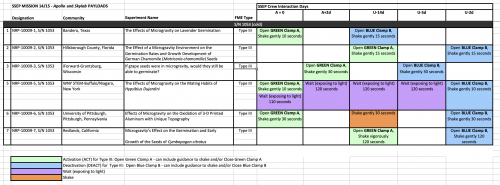To all communities that started Mission 16 to ISS on September 1, 2021, your experiments are next to launch in late Spring 2022.
The SpaceX CRS-23 vehicle carrying experiments from the SSEP Apollo and Skylab payloads for Mission 14 and 15 to the International Space Station (ISS) blasted off from Space Launch Complex 39A (SLC-39A) at NASA’s Kennedy Space Center in Florida, at 3:14 am EDT on Sunday, August 29, 2021. At 10:30 am EDT, Monday, August 30, 2021, traveling at over 17,000 miles per hour (27,500 km/hr), at an altitude of 270 miles (440 km) above Earth, the SpaceX Dragon spacecraft autonomously linked up with ISS.
A Window on SSEP Spaceflight Operations – This is the Real Space Program
The Apollo and Skylab experiments were transferred to ISS, and NASA astronaut and ISS Flight Engineer Shane Kimbrough activated 3 of 6 SSEP experiments on schedule on Tuesday, August 31, 2021. These activations were pre-planned activities defined by the student flight teams for day of Arrival at ISS (designated A=0).
Flight Engineer Kimbrough activated the experiments at 4:10 am EDT. Details of the activation on orbit were then communicated to Earth, to Marshall Space Flight Center, and then in turn to Johnson Space Center and to our launch services provider, Nanoracks. Nanoracks then informed the National Center for Earth and Space Science Education at 10:18 am EDT, just over six hours after on-orbit activation. The Center then formally recorded the activity on the SSEP Mission 14/15 to ISS Experiment Log page.
This communications pathway is critical for experiment success. The student flight teams are using the information provided on the Log page to carry out concurrent ground truth experiments. Conducting identical experiments on the ground is critical. Once the flight experiment (operating in the apparent absence of gravity) is returned to Earth, an analytical comparison with the ground experiment (operating in the presence of gravity) allows the role of gravity to be assessed for the physical, chemical, or biological system under study.
There are 5 scheduled Crew Interaction Days with the Apollo and Skylab experiments: Arrival day (A=0); Arrival plus 2 days (A+2); Undock minus 14 days (U-14); Undock minus 5 days (U-5); and Undock minus 2 days (U-2). The schedule of available Crew Interaction Days for SSEP is one of many real spaceflight operational constraints that all student teams must take into account when designing and proposing SSEP experiments. Click on the graphic at right to see the Crew Interaction Schedule for Apollo and Skylab experiments, which were integrated into the overall ISS crew schedule by Marshall Space Flight Center and Nanoracks months before launch as part of lock-down of the flight configuration for all SSEP experiments.
At 9:45 am EDT, Thursday, September 2, 2021, Flight Engineer Shane Kimbrough carried out the scheduled A+2 activation of 2 more Apollo and Skylab experiments.
To provide a sense of the formal communications for Apollo and Skylab experiment activity, below is the A+2 Operations Nanoracks communique received by the National Center for Earth and Space Science Education providing the details of the on-orbit activities:
Nanoracks Communique
Arrival at ISS A+2d interaction as follows:
Nanoracks Module 9
ISS Crew Member Shane Kimbrough performed the following Nanoracks Mixture Tube interactions on-orbit on Thursday, September 2, 2021. The interaction began approximately at 13:45 GMT. The crew reported that all ops were nominal.
The following clamps were opened:
S/N 1053
Tube Community
3 iForward-Grantsburg, WI (green)
5 Buffalo, NY (no clamps were opened)
The following experiments were shaken:
S/N 1053
Tube Community
3 iForward-Grantsburg, WI (gently, 30 seconds)
5 Buffalo, NY (exposed to light, 120 seconds)
Unexpected Events: n/a
Topics for resolution: n/a
The Student Spaceflight Experiments Program (SSEP) is a program of the National Center for Earth and Space Science Education (NCESSE) in the U.S., and the Arthur C. Clarke Institute for Space Education internationally. It is enabled through a strategic partnership with NanoRacks LLC, working with NASA under a Space Act Agreement as part of the utilization of the International Space Station as a National Laboratory. SSEP is the first pre-college STEM education program that is both a U.S. national initiative and implemented as an on-orbit commercial space venture.
The Smithsonian National Air and Space Museum, Center for the Advancement of Science in Space (CASIS), and Subaru of America, Inc., are National Partners on the Student Spaceflight Experiments Program.


Comments are closed.